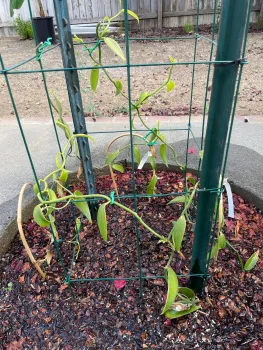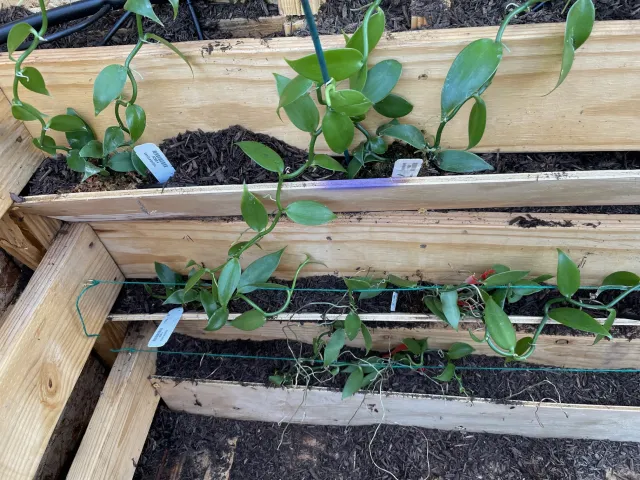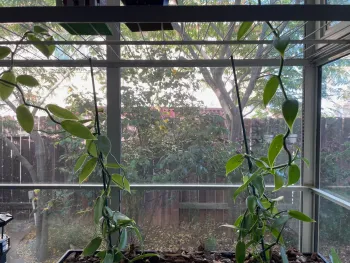Article by Vincent Hughes
Did you know that you could grow one of the world’s most valuable spices right here in Solano County? The spice I’m talking about is none other than vanilla, or Vanilla planifolia, and yes, you can grow it for yourself right here at home.
V. planifolia is a vining orchid native to Central and South America that is commonly grown in the tropics, such as Mexico, Tahiti, and Madagascar, which are the largest producers of vanilla. Growing best in hot, humid climates, the ideal temperatures for cultivation are 15 - 30 degrees Celsius or 59 - 86 degrees Fahrenheit during the day and 15 - 20 degrees Celsius or 59 - 68 degrees Fahrenheit at night with 80% humidity. Natively in Mexico, it grows upwards on the trunks of trees, receiving filtered light, which prevents it from becoming sunburned. All of this would seem to indicate that it could not grow well here.
A quick search among nurseries that carry and sell vanilla, however, reveals that they list it as being growable in zones 3 – 11 in patio settings or zones 9 – 11 outdoors. Being someone who loves both vanilla as a flavor and a scent, as well as orchids, I was thrilled to see this three years ago when I decided to then grow my own vines.
In March of 2022, I placed my first order for four vines, which, upon arriving, I placed in my kitchen window to grow until we reached warmer temperatures. I had decided that since I was living quite comfortably in zone 9, I would raise my vines outdoors. And in May of that year, I moved them from my comfortable kitchen window outside to a circular planting space in the center of my yard. With the shade provided by my mature plum tree, I thought that the vines would grow well there on the trellis that I provided for them to hold on to. Over the summer, my vines thrived in our climate and grew rapidly, quickly reaching the top of the trellis. But as the autumn came, my luck began to turn. With incoming cold temperatures in October and November, I built a small greenhouse of plastic and scrap wood, hoping that I would keep the frost away from the vines. However, the plastic I utilized to protect the vines cut off the sunlight they needed, which caused them to wither. And when I attempted to open the greenhouse to allow sunlight in, the cooler temperatures coupled with torrential rain and flooding finished them off, ending my first attempt at raising vanilla.

Undeterred, however, I ordered a new batch in June of 2023. Ordering a larger, more mature vine, I reflected on the lessons I had learned from my first year of growing and decided that I would not repeat them. Moving to a new spot along my fence line, I planted my vine on a slope in my yard, with a trellis for it to grasp onto and grow up along my fence. Given the slope, I did not have fears of flooding. And with the shelter provided by both my plum tree from the previous year and my cherry tree, I felt that the vine had adequate protection from the sun. Similarly to the previous year, I saw significant growth over the summer months and bought burlap to shield it with in the fall and winter from the frost. This strategy worked for me much better than the prior year’s makeshift greenhouse had. However, during a week of more warmly forecasted nights, a sudden and unexpected frost caught my vine unprotected and again cost me months of growth.
I remained undeterred despite the setbacks. I was determined to successfully grow vanilla here in Solano County. So, for 2024, I decided on a new plan. In May of that year, I built a small greenhouse out of old pallets I had recycled from my work, some clear plastic roof sheeting, an old floor fan, and a five-gallon bucket. In hopes of protecting the new vanilla vines, I had designed the greenhouse to keep temperatures at an ideal range while also humidifying the space for the vines. I ran a dedicated irrigation line into the greenhouse to irrigate the vines while inside. And to monitor it all, I placed a battery-powered temperature and humidity sensor inside, which connected to my home Wi-Fi network to allow me to monitor the greenhouse conditions at any time from anywhere. But with that ability to monitor came one of the hottest summers I had experienced in Solano, with temperatures regularly over 100 degrees Fahrenheit and as high as 118 degrees. After a long fight against the hot summer weather, my vines again sadly perished.

After three successive years of growing outdoors and struggling to fight the elements, I decided on a new course of action for this year: to convert my kitchen window, in which all of my vines had spent time and done well, into a growing space for vanilla. My first two vines arrived in April of this year, and in the time since they arrived, they have grown approximately six inches each. A third vine, V. planifloia ‘Variegata’, arrived at the very beginning of June. Using my temperature and humidity sensor from last year, I have carefully tracked the temperature and humidity inside the window since placing it into the space. In that, I have begun to track and catalogue what appears to be the ideal growing conditions for vanilla in our county.

I have found that vanilla grows best in protected environments, sheltered from the variable conditions of our local climate, such as you would find indoors or inside a greenhouse. It favors being grown in east-facing windows, which allow it to benefit from soft, morning light while being sheltered from the intense, afternoon sun. It requires a trellis or pole to wrap around and hold on to as it grows upwards, with plenty of space to grow, as a mature vine can reach a length of twenty feet. Vanilla, like other orchids, requires well-draining, aerated soil. I have found that a mixture of well-draining orchid soil and nutrient-rich potting soil is very effective for stimulating growth. And with the data collected from my temperature and humidity sensor, I have found that an average temperature of 73.3 degrees Fahrenheit with an average humidity of 50.2% has led to the best growth overall.
Growing vanilla at home is a long-term process if your goal is to collect your own vanilla beans. Vines started from a healthy, mature cutting can take between two and five years to mature and flower. Flowering typically occurs when a mature vine is between 6 – 13mm in diameter, but can be influenced by temperature, humidity, and light. Flowering can occur over a period of two months, but individual flowers only last for one day, during which they must be hand-pollinated to produce a vanilla bean. Once a flower opens, you have twelve hours in which you can pollinate it. With successful pollination, it takes 8 – 9 months for a seed pod (a vanilla bean) to mature. And once you harvest, it takes several months of curing to enhance the flavor for use in the kitchen.
If you want to try growing your vanilla at home, you will want the following things to be successful:
- A protected space with filtered light.
- A temperature and humidity sensor to monitor conditions around your vines.
- Plenty of patience and a drive to find what works best for your growing space.
Good luck, and happy growing!
thumbnail photo: "Vanilla Beans" by kendiala is licensed under CC BY-NC 2.0.

